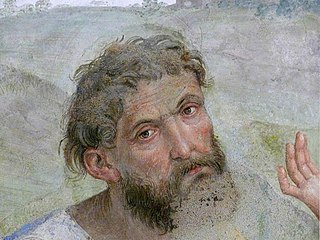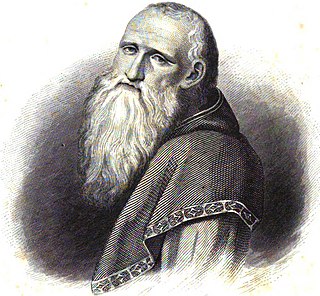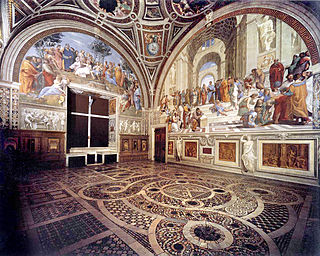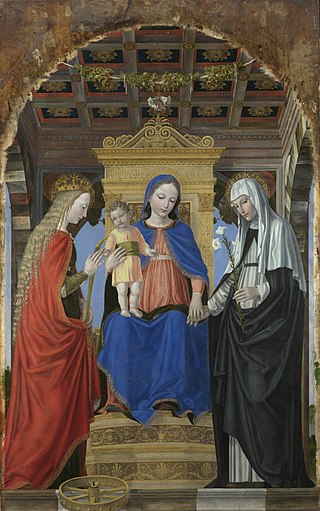
Fra Bartolomeo or Bartolommeo, also known as Bartolommeo di Pagholo, Bartolommeo di San Marco, Paolo di Jacopo del Fattorino, and his original nickname Baccio della Porta, was an Italian Renaissance painter of religious subjects. He spent all his career in Florence until his mid-forties, when he travelled to work in various cities, as far south as Rome. He trained with Cosimo Rosselli and in the 1490s fell under the influence of Savonarola, which led him to become a Dominican friar in 1500, renouncing painting for several years. Typically his paintings are of static groups of figures in subjects such as the Virgin and Child with Saints.

The Chi Rho is one of the earliest forms of Christogram, formed by superimposing the first two (capital) letters—chi and rho (ΧΡ)—of the Greek word ΧΡΙΣΤΟΣ (Christos) in such a way that the vertical stroke of the rho intersects the center of the chi.

Lo Spagna, "the Spaniard" in Italian, was a painter of the High Renaissance, active in central Italy. His name was Giovanni di Pietro, but he was known as Lo Spagna because he was born in Spain. After Raphael, he was a main pupil and follower of the Umbrian painter Perugino, whose style his paintings develop. He should not be confused with Pietro di Giovanni D'Ambrogio of Siena.

Sebastiano del Piombo was an Italian painter of the High Renaissance and early Mannerist periods famous as the only major artist of the period to combine the colouring of the Venetian school in which he was trained with the monumental forms of the Roman school. He belongs both to the painting school of his native city, Venice, where he made significant contributions before he left for Rome in 1511, and that of Rome, where he stayed for the rest of his life, and whose style he thoroughly adopted.

Bernardino Luini was a north Italian painter from Leonardo's circle during the High Renaissance. Both Luini and Giovanni Antonio Boltraffio were said to have worked with Leonardo directly; he was described as having taken "as much from Leonardo as his native roots enabled him to comprehend". Consequently, many of his works were attributed to Leonardo. He was known especially for his graceful female figures with elongated eyes, called Luinesque by Vladimir Nabokov.

The four Raphael Rooms form a suite of reception rooms in the Apostolic Palace, now part of the Vatican Museums, in Vatican City. They are famous for their frescoes, painted by Raphael and his workshop. Together with Michelangelo's Sistine Chapel ceiling frescoes, they are the grand fresco sequences that mark the High Renaissance in Rome.

The Chigi Chapel or Chapel of the Madonna of Loreto is the second chapel on the left-hand side of the nave in the Basilica of Santa Maria del Popolo in Rome. It is the only religious building of Raphael which has been preserved in its near original form. The chapel is a treasure trove of Italian Renaissance and Baroque art and is ranked among the most important monuments in the basilica.

"In hoc signo vinces" is a Latin phrase conventionally translated into English as "In this sign thou shalt conquer", often also being translated as "By this sign, conquer".

The Legend of the True Cross or The History of the True Cross is a sequence of frescoes painted by Piero della Francesca in the Basilica of San Francesco in Arezzo. It is his largest work, and generally considered one of his finest, and an early Renaissance masterpiece.

The Garvagh Madonna is an oil painting by the Italian Renaissance artist Raphael, dating to c. 1509–1510. It depicts the Virgin, the Christ Child and the infant John the Baptist, and is one of many paintings by Raphael with this trio. It is from early in the artist's third, or Roman period, in which distinctive changes are seen from his Umbrian or Florentine period in style and use of colour, with the introduction of more natural subjects and settings.

The Baptism of Constantine is a painting by assistants of the Italian Renaissance artist Raphael. It was most likely painted by Gianfrancesco Penni, between 1517 and 1524.

Scala Regia is a flight of steps in the Vatican City and is part of the formal entrance to the Vatican. It was designed by Gian Lorenzo Bernini.

The Meeting of Leo I and Attila is a fresco by the Italian Renaissance artist Raphael. It was painted from 1513 to 1514 as part of Raphael's commission to decorate the rooms that are now known as the Stanze di Raffaello, in the Apostolic Palace in the Vatican. It is located in the Stanza di Eliodoro, which is named after The Expulsion of Heliodorus from the Temple.

The Donation of Constantine or Donation of Rome is a painting by assistants of the Italian renaissance artist Raphael. It was most likely painted by Gianfrancesco Penni or Giulio Romano, somewhere between 1520 and 1524. After the master's death in 1520, they worked together with other members of Raphael's workshop to finish the commission to decorate with frescoes the rooms that are now known as the Stanze di Raffaello, in the Apostolic Palace in the Vatican. The Donation of Constantine is located in the Sala di Costantino. It was inspired by the famous forged documents that supposedly granted the Popes sovereignty over Rome's territorial dominions.

The Battle of the Milvian Bridge, or The Battle at Pons Milvius, is a fresco in one of the rooms that are now known as the Stanze di Raffaello, in the Apostolic Palace in the Vatican depicting the Battle of the Milvian Bridge.

The mystical marriage of Saint Catherine covers two different subjects in Christian art arising from visions received by either Catherine of Alexandria or Catherine of Siena (1347–1380), in which these virgin saints went through a mystical marriage wedding ceremony with Christ, in the presence of the Virgin Mary, consecrating themselves and their virginity to him.

The Prophet Isaiah is a fresco located in Basilica di Sant'Agostino, an early Renaissance church in Rome. It is an Italian Renaissance painting, influenced by Michelangelo's work on the Sistine Chapel ceiling.

The St. Cecilia Altarpiece is an oil painting by the Italian High Renaissance master Raphael. Completed in his later years, in around 1516–17, the painting depicts Saint Cecilia, the patron saint of musicians and Church music, listening to a choir of angels in the company of St. Paul, St. John the Evangelist, St. Augustine and Mary Magdalene. Commissioned for a church in Bologna, the painting now hangs in that city's Pinacoteca Nazionale. According to Giorgio Vasari the musical instruments strewn about Cecilia's feet were not painted by Raphael but by his student, Giovanni da Udine.

The Vision of Constantine was an egg tempera painting created by Elias Moskos. Moskos was active during the 17th century. Fifty-two paintings are attributed to the artist. He was active on the Greek islands of Crete and Zakynthos. He is one of the few artists that belongs to the Cretan school and the Heptanese School. Constantine is one of the most important figures in the Christian religion. He was the first Roman emperor to accept the new faith. He has been depicted in art since the inception of the new religion. He is often depicted with his mother Helen. The Vision of Constantine was very popular in Greek and Italian art.

Vision of Constantine (Stavarkis) is a tempera painting created by Greek painter and goldsmith Stylianos Stavrakis. Stavrakis was a major representative of the Heptanese school. Many of his works were completed on the Ionian islands namely Zakynthos. He was active during the 1700s. He was from a prominent family of painters His student was his nephew famous Greek painter Demetrios Stavrakis.





















